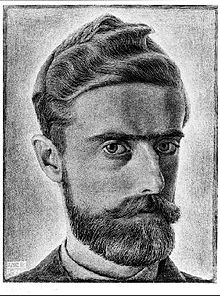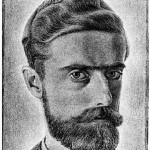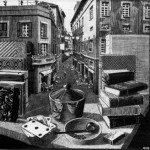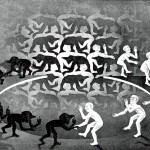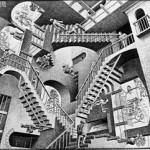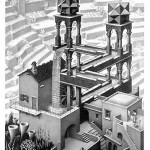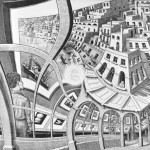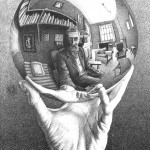Maurits Cornelis Escher is widely acknowledged for his extensive use of distorted geometrical shapes, tessellations and spatial illusions creating a unique art form that artists and mathematicians admired. Through these works of art, he contributed to the world of math without having extensive training or high academic achievements, but his work was still exhibitions of mathematical ideas.
Deterring from his father’s plans for him to become an architect, M. C. Escher grew a great interest in graphic arts. Obtaining a worldwide reputation, he was presented to the public in an article in Time magazine and had his first exhibit in 1956.
Mathematicians accepted his accomplishments in art while envisioning principles of mathematics, even though he had no teachings beyond high school in the subject. M. C. Escher quoted: “At first, I had no idea at all of the possibility of systematically building up my figures. I did not know…this was possible for someone untrained in mathematics, especially as a result of my putting forward my layman’s theory which forced me to think through the possibilities.”( 1958, M.C. Escher, Regular Division of the Plane)
His inspiration came from the readings he did on many mathematical ideas. With this knowledge, he created projective geometry, structures in-plane, Euclidean geometries, paradoxes, and “impossible” figures, and he adopted Roger Penrose’s ideas. The bulk of his work surrounds two main areas: logic of space and space geometry.
Physical objects have a spatial relation which is necessary is considered the “logic” of space; when these are disrupted, they become visual paradoxes or optical illusions. Maurits understood the relationship between space geometry and space logic determining one another. He used to experiment with light and apply it to the logic of space, and when using concave and convex objects, he would shadow.
He was also very particular about perspective, using vanishing points to create an illusion of infinity for the eye. In doing this and using specific vanishing points, he could make the elements in a picture shift. He also created a three-dimensional object from a two-dimensional representation, one of his works is based on the idea of Roger Penrose’s -the impossible triangle.
M.C. Escher contributed with tessellations, which are arranged closed shapes that cover a plane without touching or overlapping and with no gaps. He was intrigued by “metamorphoses”, 1957 his essay on tessellations has a quote in which he remarked: “In mathematical quarters, the regular division of the plane has been considered theoretically….Does this mean that it is an exclusively mathematical question?
In my opinion, it does not. Mathematicians have opened the gate leading to an extensive domain, but they have not entered this domain themselves; they are more interested in the way the gate is opened than in the garden lying behind it.” Mathematicians showed that all regular polygons, only the triangle, square, and hexagon, should be used in tessellations. Escher used reflections, glide reflections, translations, and rotations to widen his pattern availability.
In conclusion, M.C. Escher made many contributions to Algebra and math. He was a very humble man who neither considered himself an artist nonetheless a mathematician. However, without outstanding training, he still became a huge factor in how we use geometry today.
References:
- F H Bool et al., M C Escher, His Life and Complete Graphic Work (New York, 1982).
- 2.C H MacGillvary, Symmetry aspects of M C Eschers Periodic drawings (1965).
- 3.Schattschneider, Escher: A mathematician in spite of himself, in R K Guy and R E Woodrow (eds), The Lighter Side of Mathematics (Washington, 1994), 91-100.

